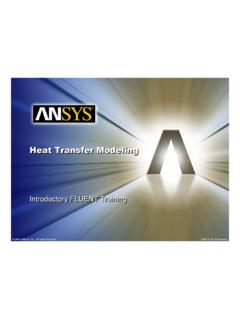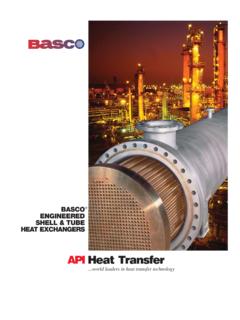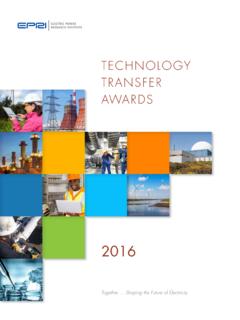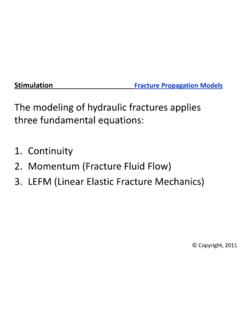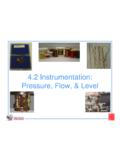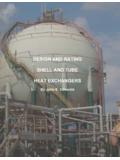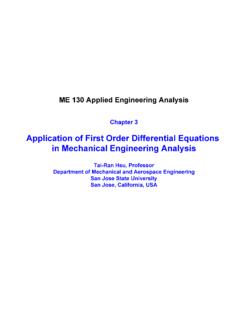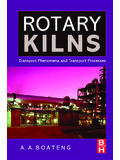Transcription of THERMAL NETWORK MODELING HANDBOOK
1 THERMALNETWORKMODELINGHANDBOOKREFORMATTE Dby K&K AssociatesTABLE OF CONTENT1. THERMAL Math MODELING as a Cognitive Process ..22. THERMAL MATHEMATICAL MODELING .. NETWORK MODELING Concepts .. Node Types .. Method of Computational Methods - Nodes .. Conductors .. Concepts .. Types of Computational Methods - Conduction Conductors .. Rectangular Circular Sections .. Parallel Conductors .. Series Conductors .. Computational Methods - Convection Combined Natural and Forced Natural Convection Equations .. Forced Convection In Tubes and Forced Convection Over Flat Plates .. Forced Convection Over Cylinders.
2 Forced Convection Over Spheres .. Computational Methods - Radiation Computational Methods - Mass Flow Energy Sources or Concepts .. Types of Heat Sources or Computational Considerations - Sources or NETWORK Solutions [not included].. MODELING Operational Parameter Relationships [not included]..294. References ..29 This HANDBOOK was originally prepared for the National Aeronautics and Space Administration, MannedSpacecraft Center, Under Contract NAS 9-10435It was excerpted and reformatted to ADOBE ACROBAT PDF format by:K&K Associates, Developers of THERMAL Analysis Kit (TAK)10141 Nelson , CO 80021 K&K Associates 1999-2000 Version THERMAL Math MODELING as a Cognitive ProcessA brief introduction to the rudimentary techniques of THERMAL MODELING coupled with a simple understandingof the various basic heat transfer mechanisms are the prerequisites for a beginning THERMAL math applied, the body of concepts, principles and techniques applicable to THERMAL math modelingconstitutes a valid engineering tool which can be applied to the solution of real engineering problems.
3 A goodlumped parameter representation of a THERMAL system requires, in addition to the basic principles andtechniques, an elusive mixture of experience (with real systems, both physical and model) and EngineeringJudgment to transfer the end product into an accurate, versatile and cost effective THERMAL math , the problems encountered in developing a THERMAL math model reduce to an overall object ofachieving the greatest accuracy for the least cost. Cost "actors are rather well defined, and fall into twoclasses: (1) the cost of developing the model, and (2) the cost of using the model. Development costs can bebased almost solely on the actual engineering manpower required to do the job within the constraints of timeand budget.
4 However, the potential costs involved in using a model are often not as obvious nor as linear. Forexample, most THERMAL math models will be analyzed on a computer which is highly prioritized. In such anenvironment, a relatively small increase in required processor time, perhaps from 5 minutes to 15 minutes,often results in a reduced job priority and a corresponding slowdown in turnaround time, perhaps from oneday to one problem of achieving accuracy in a math model, while subject to cost constraints, varies greatly from onethermal math model to another. General accuracy requirements may be as straight forward as "temperatureaccuracy shall be compatible with thermocouple A/D converter quantization error," or ".
5 Thermostathysteresis." On the other hand, accuracy levels might be indirectly indicated by requiring that a model must"be sufficiently detailed to permit meaningful parametric analyses with respect to insulation thicknessvariations in increments of 1/4 inch." Clearly, there is going to be a great deal of Engineering Judgmentinvolved in developing a model that is "sufficiently detailed" to be "meaningful."Succeeding sections of this report will present many of the basic principles and techniques involved inthermal math MODELING . Experience, of course, can only be acquired from hands-on familiarity with realthermal systems and participation in the MODELING and analysis thereof.
6 Engineering Judgment can probablybe described more accurately as the result of abstracting from the body of unique familiar information, ageneral understanding which can be extended to guide the investigation and comprehension of new andunfamiliar areas. As such, Engineering Judgment cannot be presented in a table, or a figure, or even an entirebook. However, it is possible to present a collection and discussion of examples of THERMAL math modelingwhich will serve, not as a source of practical experience, but as a body of unique and familiar informationfrom which the reader may abstract as much Engineering Judgment as he is able.
7 Such a collection is includedin the latter half of this THERMAL MATHEMATICAL NETWORK SolutionTwo systems are said to be analogous when they both have similar equations and boundary conditions; andthe equations describing the behavior of one system can be transformed into the equations for the other bysimply changing symbols of the variables. THERMAL and electrical systems are two such analogous systems asshown in table SystemElectrical s GTI = E/RTable 2-1 THERMAL -Electrical System AnalogyThe analogy between THERMAL and electrical systems allows the engineer to utilize the widely known basiclaws such as Ohm's Law and Kirchhoff's Laws used for balancing networks.
8 Numerical techniques used tosolve the partial differential equations describing such systems have been conveniently adapted to computersolutions, thus enabling the engineer to readily compute temperature distributions and gradients of complexphysical THERMAL analyzer computer programs have been developed which require the user to define a thermalnetwork of the system analogous to an electrical circuit. The NETWORK components are input into the computerand pre-programmed routines perform the transient or steady state section discusses the development of a THERMAL NETWORK and the numerical techniquesfor solving this MODELING ConceptsIn order to develop a THERMAL NETWORK and apply numerical techniques to its solution, it is necessary tosubdivide the THERMAL system into a number of finite subvolumes called nodes.
9 The THERMAL properties of eachnode are considered to be concentrated at the central nodal point of each subvolume. Each node representstwo THERMAL NETWORK elements, a temperature (potential) and a capacitance ( THERMAL mass) as shown in 2-1 Nodalization4 The temperature, T, assigned to a node represents the average mass temperature of the subvolume. Thecapacitance, C, assigned to a node is computed from the thermophysical properties of the subvolume materialevaluated at the temperature of the node and is assumed to be concentrated at the nodal center of thesubvolume. Because a node represents a lumping of parameters to a single point in space, through thesubvolume implied by the nodal temperature is linear as shown in Figure and not a step function asillustrated in Figure 2-2 Temperature Distributions In a homogeneous material, the temperature at a point other than the nodal point may be approximated byinterpolation between adjacent nodal points where the temperatures are known.
10 The error introduced by dividing a system into finite size nodes rather than volumes dx3 where dx approacheszero is dependent on numerous considerations: Material THERMAL properties, boundary conditions, node size,node center placement, and time increment of transient calculations. The techniques for proper nodalizationto minimize the error will be discussed in a later Node TypesTo this point only nodes which represent subvolumes with a finite THERMAL mass (capacitance) have beendiscussed. In many instances, two other types of nodes are required to define a THERMAL NETWORK . They arenodes having a zero capacitance or an infinite capacitance.

